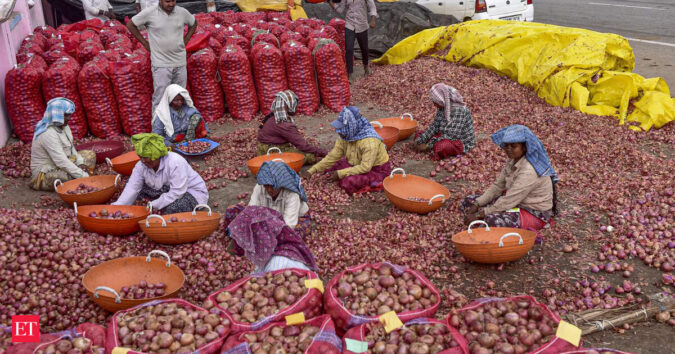“I spent around Rs 66,000 on my onion crop,” Ingle told The Times of India’s Ardhra Nair, standing by his rain-soaked field. “I’ll run a rotor through the remaining onions and turn them into fertiliser. That’s more profitable than selling.”
Across Maharashtra, stories like Ingle’s have become all too common. Relentless rains have wrecked crops — from onions, tomatoes, and potatoes to pomegranates and soyabean — while collapsing prices have left farmers with little to show for their toil. The cascading effect has reached rural markets, which usually thrive during the festive season.
“This year, Diwali is being celebrated only in cities. In villages, there’s no money even to buy a diya,” an Agricultural Produce Market Committee (APMC) member from Nashik told the newspaper.
Onions Rot, Markets Stagnate
At Lasalgaon APMC, Asia’s largest onion market, prices have been stuck between Rs 500 and Rs 1,400 per quintal, averaging around Rs 1,050 (Rs 10.50 per kg). A bumper summer crop in March-April, combined with damaged new harvests, has created a glut of poor-quality onions.
“About 80% of the onion crop in Nashik was damaged by rain,” said an APMC official. “Farmers who stored their produce hoping for higher prices are now selling at distress rates. The salvaged onions are of low quality and fetching poor returns.”Ingle’s calculations tell the story starkly. He sold 393 kg of onions at Rs 3 per kg, 202 kg at Rs 2, and 146 kg at Rs 10, earning Rs 1,729 before expenses. After paying Rs 1,065 for transport, loading and weighing, his net earnings were just Rs 664. “Being a farmer means a life of struggles,” he said.
‘Better to Destroy Than Sell’
For many, the losses extend beyond onions. Manikrao Zende, another Purandar farmer, saw his investments in pomegranates and custard apples washed away. “I spent Rs 1.5 lakh on my pomegranate farm, but the plants turned black due to nonstop rains,” he said. “I had to discard them. My custard apple saplings, worth Rs 1 lakh, sold for barely half that.”
Faced with such losses, Zende decided to destroy his onion crop altogether. “Selling would only deepen my losses. At least if I plough it back, it becomes fertiliser,” he said.
Zende also drew a link between rural distress and rising crime. “When farmer families have no money, their children are left idle. Some migrate to cities, but many stay back with no jobs and no hope. It’s no surprise some drift into crime. The day farmers get fair prices, crime will fall.”
Imported Stock, Fading Hopes
At Pimpalgaon Baswant APMC, tomatoes are selling for around Rs 1,100 per 20 kg crate. But many farmers are losing faith in the market. Manik Gore, a farmer and commissioning agent at Chakan APMC, said he sowed soyabean this year on one acre — a rare move for him. The rains wiped it out.
“My input cost was Rs 20,000, completely gone,” he said. “Even the onions coming in are spoiled. Out of 50 kg, barely 10 kg sells at a decent rate; the rest go for Rs 2–Rs 3 per kg.”
To make matters worse, produce from other states — particularly onions and potatoes from Uttar Pradesh and Gujarat — is flooding Maharashtra’s markets. “Good-quality potatoes are selling at Rs 10–Rs 15 per kg,” Gore said. “But the cost of cultivation per acre is around Rs 40,000. Whatever we’re getting now is nothing.”
Lost Markets
Gore blames government policy for deepening the crisis. “Last year, when onion prices rose, the government banned exports,” he said. “We lost our international clients to other countries. When the ban was finally lifted, the markets were gone. If the government can ban exports when prices rise, should it not buy onions at good prices when they crash?”
This, he said, reflects a pattern of neglect. “Farmers carry all the risk but get none of the reward. Farming has become a life of suffering.”
Soyabean, Toor and Chana: The Bleak Outlook
The pain isn’t limited to vegetables. In Latur, one of India’s largest soyabean markets, around half the crop has been damaged. “Good-quality soyabean is selling for Rs 4,100–Rs 4,250 per quintal, but rain-hit stock fetches only Rs 2,000–Rs 3,000,” said trader Ramesh Suryavanshi. “That doesn’t even cover half the input cost.”
Even those who stored their produce from previous seasons hoping for better prices are being forced to sell cheap. “Soyabean prices haven’t improved in two years. The rates for chana and toor dal are also weak,” Suryavanshi said. “Good-quality chana sells at Rs 5,400–Rs 5,500, while damaged stock goes for Rs 3,000. Toor dal fetches a maximum of Rs 6,800.”
For farmers, this means no surplus to spend during the festive season — and for the rural economy, no revival in sight. “Farmers have lost their purchasing power,” Suryavanshi said. “Even Diwali businesses are suffering. The overall mood is bleak.”
